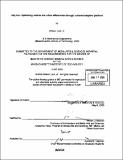| dc.contributor.advisor | William J. Mitchell. | en_US |
| dc.contributor.author | Lark, William, 1981- | en_US |
| dc.contributor.other | Massachusetts Institute of Technology. Dept. of Architecture. Program In Media Arts and Sciences | en_US |
| dc.date.accessioned | 2006-03-29T18:50:53Z | |
| dc.date.available | 2006-03-29T18:50:53Z | |
| dc.date.copyright | 2005 | en_US |
| dc.date.issued | 2005 | en_US |
| dc.identifier.uri | http://hdl.handle.net/1721.1/32506 | |
| dc.description | Thesis (S.M.)--Massachusetts Institute of Technology, School of Architecture and Planning, Program in Media Arts and Sciences, 2005. | en_US |
| dc.description | Includes bibliographical references (p. 91). | en_US |
| dc.description.abstract | Research focused on developing an innovative, yet simple automobile platform that maximizes its efficiency through shared convenience. Work was initially put into studying both current vehicles and urban architecture, in order to understand how their relationship could advance contextual awareness, social interaction, and efficient allocation of resources. Through support of General Motors and Gehry Partners, a multidisciplinary team of research students collaborated to produce dozens of design iterations of the urban vehicle. The models were designed through parametric computer aided design program, Catia®, and rapidly prototyped through the use of three-dimensional printers, Stratasys® and Z-corp®. Further studies of the designs lead to the development of a concept vehicle, "City-Car" - a convenient, efficient, and chic addition to public and private transportation in the city. City-Car is an adaptive shared vehicle that provides a fun driving experience in dense areas. Multiple design iterations of the City-Car were created to operate in a shared vehicle system. The Flex City-Car is a battery-powered dual motored vehicle able to reposition its rear powertrains to occupy a quarter less space when parked and 44-percent less individual net space when linearly stacked compared to its footprint while driving. All City-Cars promote a share a platform that can be accessed on demand for charging, networking, and cleaning to accommodate the way people live today. | en_US |
| dc.description.abstract | (cont.) An urban case study of Cambridge, Massachusetts, revealed that a one to fourteen user ratio shared vehicle system using the City-Car is able to recuperate over one-hundred acres of previously paved parking surfaces when twenty percent of driving commuters forfeit their vehicles. | en_US |
| dc.description.statementofresponsibility | by William Lark, Jr. | en_US |
| dc.format.extent | 91 p. | en_US |
| dc.format.extent | 4185589 bytes | |
| dc.format.extent | 4190129 bytes | |
| dc.format.mimetype | application/pdf | |
| dc.format.mimetype | application/pdf | |
| dc.language.iso | eng | en_US |
| dc.publisher | Massachusetts Institute of Technology | en_US |
| dc.rights | M.I.T. theses are protected by copyright. They may be viewed from this source for any purpose, but reproduction or distribution in any format is prohibited without written permission. See provided URL for inquiries about permission. | en_US |
| dc.rights.uri | http://dspace.mit.edu/handle/1721.1/7582 | |
| dc.subject | Architecture. Program In Media Arts and Sciences | en_US |
| dc.title | City-Car : optimizing vehicle and urban efficiencies through a shared adaptive platform | en_US |
| dc.title.alternative | Optimizing vehicle and urban efficiencies through a shared adaptive platform | en_US |
| dc.type | Thesis | en_US |
| dc.description.degree | S.M. | en_US |
| dc.contributor.department | Program in Media Arts and Sciences (Massachusetts Institute of Technology) | |
| dc.identifier.oclc | 61922236 | en_US |
